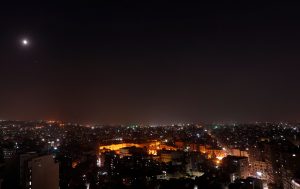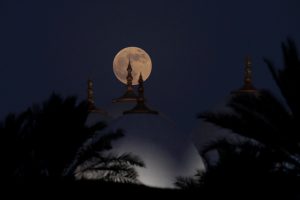By Baz Ratner and Christopher Pike
NAIROBI/ABU DHABI (Reuters) – Star gazers across much of the world sought a glimpse of a blood-red moon on Friday as the earth’s natural satellite moved into the shadow of our planet for the longest lunar eclipse of the 21st century.
From the Cape of Good Hope to the Middle East, and from the Kremlin to Sydney Harbour, thousands of people turned their eyes to the stars, hoping to see the moon which began to appear orange, brown or crimson as it moved into the earth’s shadow.

A general view during a lunar eclipse of “Super Blue Blood Moon” rising over Cairo, Egypt July 27, 2018. REUTERS/Amr Abdallah Dalsh
The total eclipse will last 1 hour, 42 minutes and 57 seconds, though a partial eclipse precedes and follows, meaning the moon will spend a total of 3 hours and 54 minutes in the earth’s umbral shadow, according to NASA.
The fullest eclipse, at 2022 GMT, will be visible from Europe, Russia, Africa, the Middle East, much of Asia and Australia though clouds could block out the moon.
In the Middle East, the moon rose above the Sheikh Zayed Grand Mosque in Abu Dhabi while in Kenya it rose over Marabou storks nesting in Nairobi’s trees.
On the banks of India’s Ganges, temples were closed ahead of the eclipse. In Singapore, enthusiasts primed telescopes at the Marina South Pier.
Hundreds of people in Australia paid to watch the eclipse from the Sydney Observatory before sunrise.
“Our event is sold out, we have about a couple of hundred people that are booked in to come and watch it with us,” said Andrew Jacob, curator at the Sydney Observatory, located right near the Harbour Bridge.
When the moon moves into the conical shadow of the earth, it goes from being illuminated by the sun to being dark. Some light, though, will still reach it because it is bent by the earth’s atmosphere.

A lunar eclipse of a full “Blood Moon” rises behind the Sheikh Zayed Grand Mosque in Abu Dhabi, United Arab Emirates July 27, 2018. REUTERS/Christopher Pike
“It’s called a blood moon because the light from the sun goes through the earth’s atmosphere on its way to the moon, and the earth’s atmosphere turns it red in the same way that when the sun goes down it goes red,” Andrew Fabian, professor of astronomy at the University of Cambridge, told Reuters.
At the same time, Mars is be traveling closer to earth than it has been since 2003, so some observers may see what looks like an orange-red star – and is, in fact, the red planet.
“It is a very unusual coincidence to have a total lunar eclipse and Mars at opposition on the same night,” said Robert Massey, deputy executive director of the Royal Astronomical Society, who will try to watch the eclipse from the Mediterranean Sea.
For thousands of years, man has looked to the heavens for omens of doom, victory and joy. The Bible contains references to the moon turning blood and some ultra-Orthodox Jews consider lunar eclipses ominous and a cause for moral contemplation.
According to Hindu beliefs, celestial bodies like the sun and moon emit negative energy during an eclipse and so some temples in India were closed to minimize any disturbance.
Astronomers, though, said there was no cause for worry.
“There is no reason to believe that blood moons foretell doom,” said Massey. “This does not herald the apocalypse: seeing a lunar eclipse and Mars in the sky is something people should enjoy rather than worry about.”
The eclipse of the moon will not be visible from North America or most of the Pacific. The next lunar eclipse of such a length is due in 2123.
(Writing by Guy Faulconbridge in London; Additional reporting by Dan Williams in Jerusalem; Editing by Hugh Lawson and Andrew Bolton)
 A full moon rises behind the Temple of Poseidon before a lunar eclipse in Cape Sounion, near Athens, Greece, July 27, 2018. REUTERS/Alkis Konstantinidis
A full moon rises behind the Temple of Poseidon before a lunar eclipse in Cape Sounion, near Athens, Greece, July 27, 2018. REUTERS/Alkis Konstantinidis
